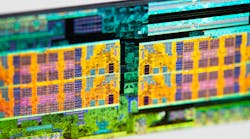Applied Materials Signals More Memory, Logic Chip Demand in 2021
Applied Materials, the world’s largest supplier of semiconductor manufacturing gear, said that its sales for the fourth quarter soared more than 20% and that the surge would continue in the current quarter, signaling that it has weathered the worst of the fallout from the coronavirus.
The Santa Clara, California-based company predicts sales of $4.75 billion to $5.15 billion in the first three months of 2021, up from $4.16 billion in the first quarter of 2020. Applied Materials projected profits of $1.20 to $1.32 per share in the latest quarter as sales of memory and computer chips continue to recover and customers roll out upgrades to production plants.
Gary Dickerson, president and chief executive officer at Applied Materials, said: “Our future opportunities have never looked better and, as powerful technology trends take shape, we are uniquely positioned to accelerate our customers’ roadmaps and also outperform our markets.” He added that the "demand for our semiconductor systems and services remains very strong."
Applied Materials is one of the linchpins of the global chip business, selling tools that are used to manufacture memory chips, processors, and other components crammed in everything from smartphones to cars. The equipment it sells is used to roll out nearly every chip and advanced display in the world. The company is widely seen as a barometer for overall demand for chips.
Applied Materials sells to all of the largest manufacturers of chips in the world, including Intel and Samsung. It also sells to contract chip manufacturing leader TSMC, which rolls out chips for over 500 customers, including Apple, Qualcomm, Nvidia, and Advanced Micro Devices. Its top customers tend to place orders months in advance to prepare for future demand.
The company's quarterly sales jumped by about 25% to $4.69 billion from $3.75 billion year over year, buoyed by bolstered demand for memory chips as well as investments in computer chips. The company's net profit totaled $1.31 billion, or $1.23 per share, up from $698 million, or 75 cents a share, a year ago even as the virus continues to spread uncontrollably around the US.
Applied Materials is also seeing stronger demand from TSMC, the largest contract foundry in the world, and other made-to-order chip manufacturers. TSMC has burned through billions of dollars to protect its lead in advanced chip production, including the 5-nanometer node, which uses among the most complex manufacturing tools in the world. TSMC has forecast capital spending of $17 billion for the year on improved demand for 5G phones and data centers.
The Silicon Valley company is also prospering as Intel and other rivals try to dethrone TSMC. Intel is pushing ahead with the development of more advanced production plants, where it is falling further behind TSMC. Intel is struggling against delays in rolling out high-end chips on its 7-nanometer process. Samsung is hoping to close its technology gap with TSMC by 2022.
“This gives us confidence that current investment levels are sustainable into 2021," Dickerson said on a conference call with analysts. "The demand for semiconductors remains very strong."
The market for memory chips is also recovering from a prolonged collapse, he said. Applied Materials said that spending has soared as manufacturers of memory chips, including Micron Technology and Samsung, move ahead with mass production of more advanced 3D NAND and DRAM. "In memory, spending is growing faster than foundry and logic last year," Dickerson said.

